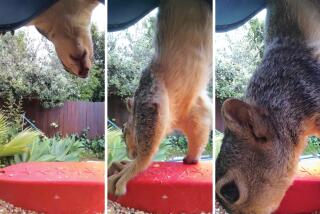Bogus Critter Ridders
- Share via
When Susan Peters moved to Manhattan Beach from rural Wisconsin five years ago, she was sure of one thing:
She wouldn’t have to worry about hitting a deer with her car.
But it didn’t take her long to discover she hadn’t completely escaped problem wildlife.
Peters was surprised to find raccoons denning in her attic, opossums eating her cat’s food and roosting birds ruining the paint job on her new truck.
In fact, heavily urbanized Southern California is rampant with wildlife. Opossums, raccoons, coyotes, foxes, bobcats, deer, gophers, even mountain lions are an increasing presence as urban borders expand and animals adapt to living with humans.
Another thing that surprised Peters was the hefty prices of the latest and greatest gadgets touted to keep wildlife off her property and out of her garbage cans.
“I’ve spent an embarrassing amount of money to keep these animals out, but they keep coming back,” said Peters, 32, a public relations representative.
She isn’t alone. In the Los Angeles area, it is estimated that as many as 60% of households experience conflicts with wildlife.
In the United States, wildlife-related damages reach nearly $4 billion a year, according to Michael Conover, director of the Berryman Institute, Utah State University’s wildlife think tank.
So, sooner or later, most Southland residents will be faced with having to expel, repel or otherwise deal with a pesky wild animal on their property.
To meet this market potential, pest control manufacturers have developed an arsenal of products to combat homeowners’ unwanted visitors.
Homeowners can find the products through catalogs, in home-improvement centers, hardware stores, nurseries and even on television in increasing numbers.
Most of these devices are wildly creative, harking back to the days of wonder cures sold from soapboxes. Although some have been around for years, with minor variations and aggressive marketing slants, customers and profits continue to pour in.
But these gizmos and gadgets won’t help. Most of them don’t work for long, if at all. The fact that these products are so widely marketed is less because they work than because the field is only lightly regulated.
In fact, the government agency responsible for regulating pesticides, the federal Environmental Protection Agency, doesn’t require proof that a repellent is effective, only that it is nontoxic and harmless to the environment.
Because of this, new products made from the same ineffective ingredients continue to pummel the marketplace.
Electronic Devices
Here is a rundown of the most common gadgets being marketed today.
Topping the list are various ultrasonic machines designed to scare away anything from insects to bats.
“These are the biggest public rip-off,” said Rex Baker, a wildlife scientist at Cal Poly Pomona. “Consumers should know that if it sounds too good to be true, it usually is.”
Baker, who also runs a pest management consulting business, said that many of these businesses are short-lived. “They close shop, change their product name and address and then reopen at another location,” he said.
One shoe-box-size device promises to drive away nuisance birds. Depending on the distributor, costs range from $100 to $500. The devices allegedly emit sounds in the range above 20,000 hertz. Unfortunately for consumers, most birds don’t hear in this range.
Another particularly popular and slickly marketed gizmo is designed for use against moles and gophers. The devices are available in all shapes and sizes, but the principle is the same as for the bird repellers.
The difference, manufacturers claim, is that the gopher machines use a wider sound range (from 5,000 to 50,000 hertz), thereby ensuring that the animals will hear it (and you will too).
What the manufacturers neglect to mention is the well-known fact--at least known by homeowners who suffer with gopher and mole mounds--that these rodents are persistent and adaptable.
Rather than flee their tunnel systems, they will muffle the irritating noise by heaping dirt against the machine. Some homeowners insist that these irritations actually cause gophers to build more mounds.
Available through most garden and home improvement catalogs, gopher repellers cost about $60 and will “protect” roughly 1,600 square feet, according to marketing claims. For most homeowners with a standard quarter-acre lot, the investment would involve four units at a cost of $240.
But experts agree that the real problem is that wild animals get used to almost any irritant.
“Evolution favors habituation,” said Robert Schmidt, a professor at Utah State and moderator of the Wildlife Society’s Internet chat line.
“Imagine an animal who’s constantly afraid of lightning,” Schmidt said. “He wouldn’t be successful in terms of survival or reproduction. It is to his advantage to become used to irritants.”
Sprays and unpleasant-tasting foods have gained increasing popularity among people who squirm at the thought of killing furry animals.
However, there is no evidence to show that products that rely on “taste aversion” actually work. In fact, repeated experiments indicate animals are insensitive to bitter tastes.
Some of the leading taste-aversion products on the market claim to prevent animals from ransacking garbage cans and foraging deer from denuding trees, keep leashless pets off lawns and even prevent squirrels, rats and mice from gnawing trees, fences, siding and outdoor furniture.
Snake Repellent
At UC Davis, researchers tested one liquid product designed to repel snakes. The solution, 7% naphthalene (moth balls) and 28% sulfur (sulfur mimics predator scents), was touted as a sure-fire critter ridder.
The rattlers and gopher snakes tested seemed to dislike the scent, although most of them slithered their way over it anyway.
In their report, the researchers concluded that it would be “unwise” to rely on the product.
Newer versions of a scarecrow--lifelike statues, silhouettes and kites mimicking owls, hawks and other predators that birds fear--are supposed to scare away nuisance birds such as pigeons, sparrows and grackles.
Businesses often use these predator models to protect entrances, and homeowners hope they’ll keep birds away from their fruit trees and new paint jobs. Like scarecrows, these gizmos are ineffective.
The latest in predator effigies are large vinyl balloons with holographic eyes that sway in the breeze. The added element of motion, however, isn’t alarming enough to frighten birds away for any length of time.
When people have a problem with urban wildlife, said scientist Schmidt, “they react by doing several things all at once.” And success is often attributed to the thing they spent money on, rather than to the unglamorous methods they began with.
Scant Evidence
Because scientific evidence supporting these gadgets is nonexistent, the companies that make them rely on testimonials of people who experience what Schmidt calls “the placebo effect.”
This may explain why these predator effigies are such big sellers at the store but such poor performers at home. Consumers want to believe they work.
Perhaps the biggest scam on the market is deer whistles, dismissed by wildlife managers as “biological nonsense.” Although originally introduced in the early ‘80s, new and “improved” versions sound as though they would work.
Travelers heading to the mountains will find these small bumper- or hood-mounted devices, priced from $2 to $20, on the shelves in gas stations and truck stops.
Experts agree that driving slowly and watching the roadsides is cheaper and more successful than a deer whistle at any price.
Damage control is one of the hot issues in wildlife management, but until public pressure to develop effective and economical solutions grows, companies will continue to sell products developed without any basis in science.
In the meantime, the business of making and selling gadgets to separate us from our wild neighbors rages on. Buyers beware.
(BEGIN TEXT OF INFOBOX / INFOGRAPHIC)
Critter Problems? Let Us Help You
Having troubles with urban wildlife? Got questions about homeowner-critter conflicts?
Help is on the way.
The author of “Bogus Critter Ridders,” Andrea Kitay, will soon begin writing a question-and-answer column titled “Living With Wildlife,” which will appear twice a month in the Real Estate section.
Kitay has a master’s degree in wildlife science from Texas A&M; University and ran her own wildlife management company, helping homeowners with backyard visitors.
She takes a moderate approach to dealing with pesky wildlife, and tries to include humane options among her suggestions for bedeviled homeowners.
Send your critter queries to Andrea Kitay at P.O. Box 2489, Camarillo, CA 93011, or via e-mail at [email protected].
All questions will be considered for use, but cannot be answered individually.
More to Read
Inside the business of entertainment
The Wide Shot brings you news, analysis and insights on everything from streaming wars to production — and what it all means for the future.
You may occasionally receive promotional content from the Los Angeles Times.










